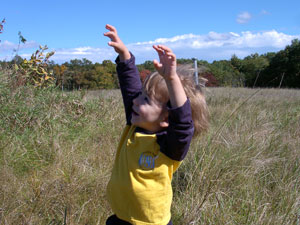It seems like I spent most of my childhood in the 1960’s outside, playing hide and seek, catching frogs, looking for four leaf clovers, and peering at pond water through a toy microscope. At one point, I was apparently the only person in the State of Pennsylvania to have been bitten by a mole. The authorities were convinced it must have been rabid, even though my parents explained that it happened while I was trying to stuff the creature into a milk bottle.
 |
| Let children experience nature at their own pace and in their own way. |
I was fortunate to live in a place where open space was within blocks of our home. Some of my fondest memories are of nature walks with a neighbor. He had no children of his own, but loved the outdoors. I still remember the thrill of discovering an arrowhead in a recently plowed farm field. The image of a pair of Painted Turtles basking on a log, with the sun streaming down on them through the forest canopy, remains with me to this day.
Today, many children are so pasted to the TV or computers that they literally have to be thrown outside with the door locked behind them (and then they have fun). Some even play handheld computer games during school recess. Two out of 10 children in the U.S. are clinically obese. Research suggests that children who are exposed to nature early and in an ongoing, positive manner thrive intellectually, spiritually and physically in ways that their "shut-in" peers do not. Nature play has been found to reduce stress, sharpen concentration, and promote creative problem solving.
“Time in the woods helps children develop bonds with nature and other people,” says CT DEP Commissioner Gina McCarthy, speaking on her No Child Left Inside initiative. “If we raise an entire generation of children with little or no appreciation for the natural world, when they grow up, they will have little understanding about it or desire to protect it.”
Now that school is out, consider having your children spend at least one “green hour” a day outside. Playing organized sports doesn’t count. Neither does just reading or watching a TV show about nature – it needs to be personal. “It’s one thing to read about a frog, it’s another to hold it in your hand and feel its life,” says Richard Louv, author of Last Child in the Woods: Saving Our Children from Nature-Deficit Disorder . .
Here are some ideas to peak their curiosity, and spark an appreciation of the outdoors and the ecosystem. Some of these activities are suitable for any season.
- Go kite flying, star gazing, canoeing, bike riding, or cloud watching. Wade or swim in a local pond or lake. Collect seashells by the seashore.
- Go fish. All you need is a small hook, some fishing line, a bobber, a stick and some water. In CT, children under 16 don’t need a fishing license.
- In winter, go sledding, cross country skiing or ice skating, or search for animal tracks in the snow.
- Make a game of it. Play bug or bird bingo (cut and paste pictures on a bingo card) or go on a scavenger hunt (make a dozen or so cards with pictures of things to find, like a daisy, tadpole, lichen, Robin, poison ivy, or deer tracks.)
- Start a nature journal with drawings and observations. Make a nature collage using things collected outdoors. Make a wax paper leaf pressing. Collect and paint rocks for paperweights.
- Make a fort out of sticks and leaves. Build a house for wood fairies – I’ve seen some complete with an outhouse and swimming pool. Make a pine cone peanut butter birdfeeder. Build a birdhouse, put it up and watch what happens. Plant a butterfly garden. Get an inexpensive digital camera and take pictures of flowers or scenery.
- Try letterboxing, which combines treasure hunting, art and navigation (article to follow).
- Go for a family hike or overnight camping trip. (From 1995-2005, camping stays in our National Parks declined by 24 %.) You don’t have to own equipment - The Appalachian Mountain Club has campsites where you can rent a tent with a wooden floor or stay in a bunkhouse. They even provide tasty meals.
- Attend a nature program like those offered by the CT DEP (e.g., Goodwin Conservation Center); the Audubon Society; or Mystic Aquarium where they have many hands on programs.
- Get Iggulden’s The Dangerous Book for Boys
 , which is filled with instructions on cutting a flint head for a bow and arrow, skipping stones, playing marbles, finding north in the dark, and, of course, first aid. , which is filled with instructions on cutting a flint head for a bow and arrow, skipping stones, playing marbles, finding north in the dark, and, of course, first aid.
Many parents are worried about letting their children venture outside alone. Perhaps you can watch them through the window. Manage the fear of “stranger danger” – it is not the epidemic portrayed on the media. Of course, take sensible precautions to keep children safe from sun, snakes, cars, poison ivy and ticks. And then let them go outside to get dirty or wet, dig up a rock, climb a sturdy tree, throw sticks for the dog, stumble and get up again, and experience nature at their own pace and in their own way. We survived it and they can too. Bet Zimmerman is a Certified Environmental Professional
and member of the Woodstock Conservation Commission. |

